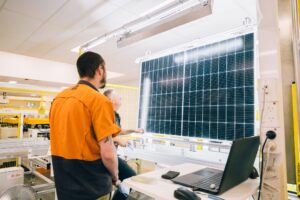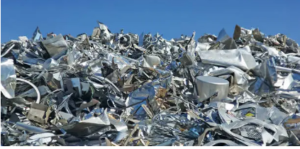Solar power systems consist of several interrelated components that work in concert to convert sunlight into usable energy. This article will introduce these main components and their functions, and provide links to additional articles which will further your knowledge of this topic.
Electric metering is an essential element of any solar PV system, not only to measure incoming and outgoing electricity but also for net metering (depending on utility regulations and state laws) purposes. Discover more here about solar meters!
Photovoltaic cells
 Photovoltaic cells convert sunlight into electricity. They form the basis for any solar power system and typically consist of two layers of semiconductor material such as silicon. One of the layers contains extra electrons from some atoms while the other does not, creating an electric field between them that generates an electric current when hit by sunlight. When shining hits these PV cells, these electrons come loose from their respective atoms to flow across the semiconductor wafer resulting in an imbalance of positive and negative electrons which create an electric current used by household appliances.
Photovoltaic cells convert sunlight into electricity. They form the basis for any solar power system and typically consist of two layers of semiconductor material such as silicon. One of the layers contains extra electrons from some atoms while the other does not, creating an electric field between them that generates an electric current when hit by sunlight. When shining hits these PV cells, these electrons come loose from their respective atoms to flow across the semiconductor wafer resulting in an imbalance of positive and negative electrons which create an electric current used by household appliances.
Solar PV cells are designed to absorb only that part of the solar spectrum that reaches Earth; this portion is known as the band gap and only photons with sufficient energy can pass through semiconductor material to produce electrons and create an electric circuit.
Scientists conducting PV research are seeking ways to increase efficiency while making them more cost-effective. Thin-film solar cells offer another solution; these versatile, lightweight panels can be made into different shapes to fit on rooftops or other limited locations with limited space.
Once produced, Tindo solar Adelaide must be assembled into modules for further use in a solar power system, along with additional components like inverters, racking, wiring, combiners and disconnects – as well as electric meters – as a component. Solar power systems may then either operate independently of other forms of power generation or connect directly to the electrical grid for use alongside traditional residential and commercial generation methods.
Concentrated solar power plants
Solar thermal power (CSP) systems generate electricity by concentrating sunlight to generate heat, which in turn powers a turbine that creates electricity. CSP plants tend not to be suitable for residential use due to their size and require significant land area with direct sunlight – which may not always be abundantly available in many locations.
Solar energy is an endlessly renewable resource that offers a sustainable alternative to fossil fuels. While PV technology has proven its worth over time, CSP can offer additional advantages regarding cost and efficiency.
CSP can be combined with storage to increase power production and reliability. Molten salt storage facilities store thermal energy that can later be used to power the grid during times of high demand or cloudy weather conditions.
There are various types of concentrated solar power (CSP) systems, such as linear concentrator and parabolic trough systems. A linear concentrator uses mirrors to focus sunlight onto a receiver tube that’s heated by heat transfer fluid; then this heated fluid drives a steam turbine that generates electricity.
Parabolic trough systems utilise long parabolic reflectors that track the sun’s rays to focus sunlight onto a receiver, heating a fluid which then powers a heat engine for electricity production. Most such systems utilise water as their heat transfer fluid; however, advanced designs are exploring using molten nitrate salts as alternative heating fluids.
Solar power towers
Solar towers (also referred to as central receiver systems) are an innovative form of concentrated solar power (CSP) technology. Utilising computer-controlled mirrors known as heliostats to track the sun on two axes and focus it onto a receiver at the top of a tall tower, which in turn heats a transfer fluid that generates steam used by conventional turbine-generators, this method produces electricity around-the-clock. When combined with energy storage solutions this approach provides for 24 hour energy generation.
Solar power towers typically operate best in sunny, dry areas that are free from clouds and provide ample sunlight, measured using Direct Normal Intensity (DNI). Solar plants employ DC-to-AC inverters that convert low voltage signals from PV panels into 120VAC or 240VAC AC current which can then be fed into the grid.
Solar power towers consist of an array of curved or flat mirrors controlled by computer to track the sun from sunrise to sunset, reflecting light back onto an energy transfer medium which heats up in response to reflection of solar radiation, heating it to produce steam that can power a turbine generator and produce power for use by turbine generators. This energy transfer medium could be liquid salt or molten salts with high conversion rates from heat into energy for production of steam power.
Environmental issues associated with Tindo solar Adelaide include bird deaths. Their reflective light can burn or kill any birds that fly into its field of reflection, and cooling these plants consumes large quantities of water which has an adverse impact on the environment.
Solar batteries
Solar batteries store excess solar energy to help homeowners avoid high utility rates or cut the power cord entirely. There is a range of sizes and technologies to choose from; gel, absorbed glass and lithium iron phosphate batteries are among the more popular choices and typically rated to 1,100 cycles or more; which you select will depend on both your electricity use and weather conditions in your area.
Solar batteries work by storing any extra energy produced from solar panels during daylight hours and using it at night or during times of peak demand or blackout. By harnessing solar with storage solutions, they can help reduce utility bills while contributing towards creating a cleaner and more sustainable world.
Installing a solar battery using a Tindo solar Adelaide system that utilises an external inverter as its input and output will ensure the appropriate size battery for your system and maximum longevity. Temperature also plays a factor, with battery capacity decreasing by 10-15 degrees Fahrenheit for every 15-20 degrees below 80.
 Recycled scrap metal has many unexpected uses – from smartphones to steel buildings! At Cohen, we take great pride in being leaders in this industry.
Recycled scrap metal has many unexpected uses – from smartphones to steel buildings! At Cohen, we take great pride in being leaders in this industry.